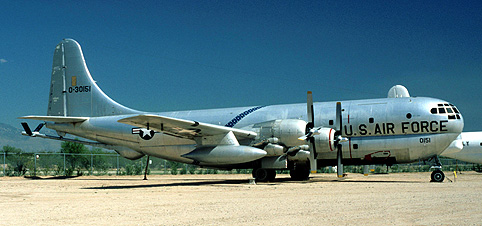
The Italian Aerospace Information Web
by Aeromedia - corso Giambone 46/18 - 10135 Torino (Italy)
Boeing KC-97G Stratofreighter (Model 367-76-66) 53-0151 in mostra al Pima Air and Space Museum di Tucson, in Arizona. L'aereo da trasporto C-97 venne sviluppato, negli anni conclusivi della seconda guerra mondiale, prendendo come base progettuale il bombardiere B-29 sul quale venne aggiunta una seconda e pių grande fusoliera. La sezione di fusoliera cosė ottenuta aveva una tipica forma ad "otto" soprannominata "double-bubble". Analoga operazione venne ripetuta poco dopo sul pių prestante B-50, dando vita al C-97A ed alle versioni successive. L'aereo della foto č uno dei 592 KC-97G costruiti, versione finale da trasporto/rifornimento in volo, spinta da quattro motori radiali turbo-supercompressi Pratt & Whitney R-4360-59B Wasp Major da 3.800 HP e riconoscibile dalle due taniche subalari. Qualche anno dopo, un'ottantina di esemplari vennero convertiti in KC-97L, con l'aggiunta di due turbogetti J-47-GE-25A in gondole subalari. (Aeromedia)
Boeing KC-97G Stratofreighter (Model 367-76-66) 53-0151 on display at the Pima Air and Space Museum near Tucson, Arizona. The basic C-97 airlifter was based on the B-29 bomber design with the addition of a second, larger fuselage section merged to the top of the original one. The resulting cross section looked like a partial figure eight, or double-bubble. Later the structural and powerplant improvements in the B-50 were incorporated into C-97A and all subsequent versions. The depicted Stratofreighter belongs to the final version KC-97G (production of 592 aircraft) powered by four 3,800 hp turbo-supercharged Pratt & Whitney R-4360-35 Wasp Major radial engines and recognizable due to external fuel tanks on two underwing pylons. More than eighty KC-97Gs were later converted to the KC-97L configuration, with the addition of two J-47-GE-25A turbojets on underwing nacelles. (Aeromedia)
